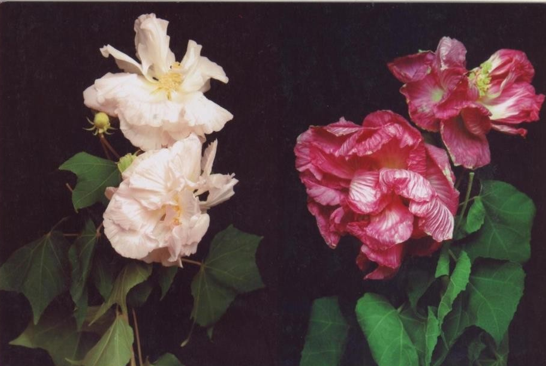Introduction
The genus Hibiscus (Malvaceae) comprises about 275 species in the tropics and sub-tropics (Dasuki, 2001), Within the Malesian region, 43 species is found. Hibiscus Mutabilis Linn. Is a large bushy shrub belonging to family Malvaceae and commonly known as changeable rose or cotton rosemallow. Plants of Hibiscus are widely planted as ornamentals and are used in traditional medicine. the species studied, leaves and flowers of H. mutabilis, believed to have emollient and cooling effect, are used to relieve swellings and skin infections (Dasuki, 2001). They are used as an antiseptic for boils and ulcers. The sap from flowers is used as coloring agent. The use of plants for medicinal purposes dates back to ancient times, with diverse cultures harnessing the therapeutic potential of botanical resources. Plants have been a valuable source of bioactive compounds, serving as the foundation for numerous pharmaceuticals and therapeutic agents. Among these plants, members of the Hibiscus genus have garnered attention due to their rich phytochemical composition and traditional medicinal uses. Hibiscus mutabilis, commonly known as the Confederate rose or Cotton rose mallow, is a notable species within these genus ornamental potential pharmacological properties.
Botanical and Ethnopharmacological Background
Hibiscus mutabilis belongs to the Malvaceae family, a diverse group of flowering plants known for their mucilaginous properties and therapeutic potential. The genus Hibiscus comprises hundreds of species distributed across tropical and subtropical regions worldwide. Ethnopharmacological studies have documented various Hibiscus species ranging from gastrointestinal disorders to skin diseases and respiratory ailments. These traditional uses underscore the rich pharmacological potential of Hibiscus mutabilis and warrant systematic scientific investigation to validate and explore its therapeutic benefits.1
Introduction to Hibiscus Mutabilis
It is an ornamental plant celebrated for its distinctive and striking flowers. It belongs to the Malvaceae family, diverse and visually appealing members. Subtropical and tropical regions of Asia, worldwide for its aesthetic appeal and adaptability.
Materials and Methods
The Hibiscus Mutabilis flower leaves are collected from the herbal garden of HIPR Dehradun [U.K] and authenticated in department of biotechnology of HIPR Dehradun.
Preparation of extract
The fresh flower leaves were washed with distilled water and air dried to constant weight. Extract was prepared by soxhlet extraction method. About 100 gm of powdered material was uniformly packed into a thimble and run in soxhlet extractor. It was exhaustible extracted with 70% ethanol; acetone and ethyl acetate for the period till the solvent in the siphon tube of extractor become colorless. After that extracts were filtered and filtrate were concentrated by evaporation to make the final volume one – fourth of the original volume and stored at air tight bottles.
Test for phytochemical constituents
Freshly prepared extracts were subjected to standard phytochemical analysis for different constituents.
Table 1
Qualitative screening of phytochemicals in ethanol, acetone and ethyl acetate leaves extracts of Hibiscus mutibulis.
The agar well diffusion assay for antibacterial activity of different spices
The agar well diffusion method was carried out to study the antibacterial activity of extracts of Hibiscus Mutabilis. Nutrient agar medium was prepared to grow the test micro organisms of Bacillus subtilis, Staphylococcus aureus, Escherichia coli and Pseudomonas. The test bacterial culture 0.1 ml was inoculated in a Petri plate containing nutrient agar and spread evenly with sterile metal spreader under sterilized conditions. A hole of 7 mm diameter was made in a nutrient agar plate containing test organisms by using sterilized cork borer and 0.1 ml of extracts 70% ethanol, acetone and ethyl acetate of Hibiscus Mutabilis were poured in those well using a micropipettes. Then these inoculated nutrient agar plates were incubated at 37°C for 24 hrs in the incubator. After incubation the zone of inhibition were observed from the size of diameter and measured in mm. 2, 3, 4
Antibiotic Streptomycin
The streptomycin susceptibility test discs are used as an antibiotic standard in this study.
Effect of pH on antibacterial activity of extracts of Hibiscus Mutabilis
To find out the effect of pH each extracts [70% ethanol, acetone and ethyl acetate] having concentration 100µg/ml were taken in three set of test tubes and 1N HCl added drop wise drop with some time interval, until the pH of extract is 2 - 5 [pH is determined by digital pH meter]. Now for making the medium alkaline (8-9 pH) by increment in pH in every extract is done by using 1N NaOH in three separate test tubes and extracts were then allowed to soaks for some time interval after that period of acid base treatment the extracts were again neutralized with using 1N HCl and 1N NaOH and then every extracts were tested for antibacterial activity by using agar disc diffusion method. 5
Table 2
Antibacterial activity of Hibiscus Mutabilis leaves with several solvent extracts of in form of Zone of inhibition (mm).
Results and Discussion
The present study revealed that ethanol was the better extractive solvent for antibacterial activity of flower leave extracts of Hibiscus Mutabilis against the selected strain of bacteria and the maximum zone of inhibition 11.48mm was recorded from 100µl of 70% ethanol extract for Escherichia coli at the alkaline medium (9pH) after 24hr and minimum zone of inhibition was recorded as 2.45 mm for 100µlof ethyl acetate for Bacillus subtilis after same time period at acidic medium (2.5 pH).As the pH of the medium get vary from acidic(2.5) to alkaline(9.0) the antibacterial activity of solvent extract of Hibiscus Mutabilis also increases. 6, 7
Conclusion
The study of the hydroalcoholic extract from Hibiscus mutabilis leaves grown in the Dehradun district of Uttarakhand has yielded insightful findings regarding its chemical composition and potential biological activities. In conclusion, the hydroalcoholic extract of Hibiscus mutabilis leaves from Dehradun district demonstrates significant potential due to its rich chemical profile and diverse biological activities. Continued research and development could unlock further applications in health and medicine, making it a valuable candidate for future exploration.



